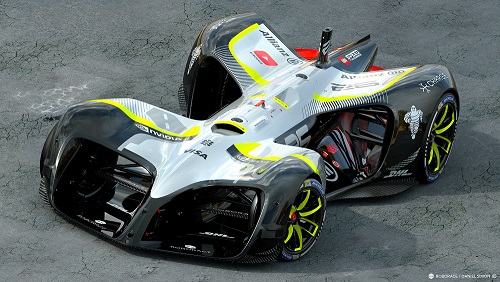Well it was only a matter of time. First, we had cruise control, then intelligent cruise control, and then driver assisted cars. Driverless cars are coming, and now we have folks questioning if we want to put people in these rolling death traps at all. Roborace and NVIDIA announced today cars that no longer need people in them. I can see Skynet, the intelligence behind the Terminator movies, suddenly virtually sit up and say, “Wow these guys get it!” Granted, this announcement has to do with race cars, which are far more dangerous than the car you are likely to drive in, but it does bring up the idea of whether we actually need to get in a car in the first place.
Let’s talk about the kinds of vehicles that really don’t need people in them.
Race Cars
One of the big problems with race cars is that you have to compromise the technology in order to preserve the life of the drivers. We could go a ton faster than we currently go if we didn’t have to worry about keeping the driver alive. Drag races have gone, in some areas and categories, from a quarter mile to an eighth of a mile, which really takes a lot of the drama, not to mention time, out of the race. NASCAR is basically slot cars with people in them anyway, with the most interesting part of the race generally occurring in the last couple of laps. And in F1, the cars are often partially crippled to make sure they can’t go dangerously fast, well, more dangerously fast, anyway. Get the drivers out of the cars (and move the audience back a bit farther from the track) and you could push the limits of the technology and even allow in top video game drivers from time to time as challengers to the pros and AIs. This could mean Man vs. Machine events where the human drivers are remotely controlling the cars by using AI assistants and racing against pure AI competitors.
You have to admit that the first Roborace car looks pretty cool.
 Image via Roborace
Image via Roborace
Maintenance Vehicles
Whether we are talking snow plows, street repair, or vehicles designed to locate problems in roads or bridges that need to be addressed, you don’t need drivers or passengers. A remote manager could be standing by just in case the vehicle’s AI ran into something it didn’t understand, but these puppies could run 24x7 and perhaps actually get ahead of our failing infrastructure.
You could even put drones in the vehicles so if they had to inspect a bridge or clear something off of power lines they could do it. Apparently one company, out of China, even has a drone with a flame thrower on it to clear power lines of junk that gets on them. Granted, I’m waiting for the story of the guy that uses that thing to get the Christmas lights off his neighbor’s home, and I expect it will end badly.
This wouldn’t be just cars and trucks either, but could also include boats and train maintenance vehicles. You don’t really need a driver to inspect tracks or canal walls; that can be done with AI.
Personal Recreation Vehicles
Now this may seem to be the ultimate in laziness, but I’m not talking about Joe six-pack sitting in his mobile home and running a full-sized off-road vehicle through the hills. I’m talking about people who have lost the use of their bodies due to illness, accident, or birth defect. They really can’t safely participate in many of the sports their friends and family do. But with a VR headset and an AI assisted robotic vehicle they could jet ski, off road explore, and pretty much go, with little or no risk, where their friends and siblings go. The reason for the AI assist is to ensure the remote vehicle doesn’t accidently hurt anyone else.
Wrapping Up
It’s funny that there are stories predicting the top five jobs robots will take over, but not one of them is a driver (even though Uber and the delivery companies are aggressively looking to do just that). I’m still not sure I’m going to want a robotic doctor who might decide to give me an instant colonoscopy while doing a prostate exam. Compared to that, this idea of replacing drivers with robots is far more benign. There are clearly a whole bunch of situations where we really don’t need people in the vehicle at all, allowing for them to be smaller, faster, safer, and do things far more cheaply than they are currently. While I still worry that many of us eventually will put on future versions of VR headsets and never take them off, for those that don’t have a choice, this trend could be a godsend, and I’m particularly looking forward to the first Roboraces thanks to NVIDIA’s Drive PX 2 and its successors.
Gentlemen, er, Robots, start your engines!
Edited by
Alicia Young